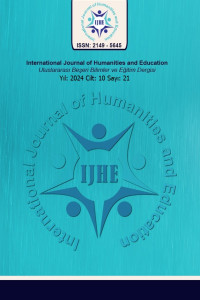Abstract
Burdur Müzesi’ndeki 18 adet madalya ve iki adet nişan bu bilimsel araştırma yazısının konusunu oluşturmaktadır. Burdur Müzesi deposundaki eserler, Kültür Varlıkları Müzeler Genel Müdürlüğü’nün 2008’deki kararlarıyla sikke envanterinden çıkarılarak; etnografik eser envanterine kaydedilmiştir. Daha önce hiçbir bilimsel araştırmada incelenmeyen eserler, ilk kez bu çalışmada ele alınarak, bilim dünyasına tanıtmak, araştırmanın en önemli amacıdır. Gümüş ve bakır malzemeden yapılmış olan madalya ve nişanlar, Osmanlı Dönemine ait kıymetli sanat eserleridir. Bu eserler, gün geçtikçe kararmakta, tasvirlerde yok olmakta ve yazılarda silinmeler meydana gelmektedir. Dolayısıyla bu taşınabilir kültür varlıklarını belgelemek, çalışmanın en önemli amaçlarındandır.
Madalya ve nişanlar, devletin kahramanlık, yararlılık ve üstün başarı gösteren başta askerlere olmak üzere kişilere verdiği, çeşitli derecelerde, onurlandırma ve değerlendirme sembolü niteliğinde objelerdir. Göğüs veya boyna asılan süslü madalya ve nişanlar, Osmanlı medeniyetine 18.yy’dan itibaren Batı medeniyetinden gelen bir kültürdür. Bu anlayışla oluşturulmuş madalya ve nişanlardan Burdur Müzesi deposunda 18 adet madalya bulunmaktadır. Bu madalyalar içerisinde Kırım Savaşı Madalyaları, Yunan Harbi Madalyaları, Kanuni Esasi Madalyaları ve Liyakat Madalyaları gibi çeşitli özel, tasvirleri ile dikkat çeken madalyalar bulunmaktadır. Abdülmecid, Abdülhamid ve V. Mehmet (Sultan Reşat) dönemlerine ait olan madalyonların üzerlerindeki kitabeler ve tuğralar okunarak; tasvirler ayrıntılı olarak betimlenmiştir. Burdur müzesinde araştırmaya konu olan madalyon ve nişanlar; belgelenerek gelecek kuşaklara aktarılmış olması, Türk tarihi ve Türk kültür tarihi literatürüne katkı sağlaması araştırmanın amaçlarındandır.
Keywords
Ethical Statement
yok
Supporting Institution
yok
Project Number
yok
References
- Koç Keskin, N. (2007), Osmanlı Şiirinde İftihar ve İmtiyaz Simgeleri ‘’Çelenk’’ ‘’Otaga’’ ve ‘’Sorguç’’ Turkısh Studies International Periodical Fort he Languages, Literature and History of Turkish Turkic, 2/7.
- Özdemir, K. (1997), Osmanlı Arması, Dönence Basım ve Yayın Hizmetleri, İstanbul.
- Tekin, K.H.(2014), ‘’Kırım Savaşı Osmanlı Hatıra ve Asker Madalyaları’’ Zeitschrift für die Welt der Türken / Journal of World of Turks, Vol 6, No 1.
Abstract
18 medals and two signs in Burdur Museum which constitutes the subject of this scientific research article. The works in the Burdur museum storehouse were removed from the inventory of coins by the decisions of the General Directorate of Cultural Assets in 2008 and its also recorded in the ethnographic works inventory. The works have not been examined in any scientific research before, which are the first handed and it carries the most important aim, which is introducing it to the world of science. Medals and signs are made from silver and copper materials, which are precious art works belonging to the ottoman period and these artifacts are darkening day by day, disappearing in depictions and being erased in writings. Therefore, documenting these portable cultural assets is one of the most important purposes of working.
Medals and signs are symbol of honor and appreciation objects, which the state first gives from person to the soldiers at various levels, especially the heroism, usefulness and superior achievement. Medallions and signs are hanged from chest or neck, which are a culture of ottoman civilization originating from the west civilization since the 18th century. There are 18 medals in the burdur museum store from medals and signs which are created for this understanding. Among these medals there are the Crimean War medals, the greek wark medals, the ottoman basic law medals and the merit medals. By reading the inscriptions and signatures on the medallions belonging to the periods of Abdulmecid, Abdulhamid and Mehmet V (Sultan Reşat); images are described in detail. The medallions and decorations that were the subject of research in the Burdur museum; The aims of the research are to document and transfer it to future generations and to contribute to Turkish history and Turkish cultural history literature.
Keywords
Project Number
yok
References
- Koç Keskin, N. (2007), Osmanlı Şiirinde İftihar ve İmtiyaz Simgeleri ‘’Çelenk’’ ‘’Otaga’’ ve ‘’Sorguç’’ Turkısh Studies International Periodical Fort he Languages, Literature and History of Turkish Turkic, 2/7.
- Özdemir, K. (1997), Osmanlı Arması, Dönence Basım ve Yayın Hizmetleri, İstanbul.
- Tekin, K.H.(2014), ‘’Kırım Savaşı Osmanlı Hatıra ve Asker Madalyaları’’ Zeitschrift für die Welt der Türken / Journal of World of Turks, Vol 6, No 1.
Details
| Primary Language | Turkish |
|---|---|
| Subjects | Cultural Geography |
| Journal Section | Research Article |
| Authors | |
| Project Number | yok |
| Publication Date | April 30, 2024 |
| Submission Date | December 12, 2023 |
| Acceptance Date | February 12, 2024 |
| Published in Issue | Year 2024 Volume: 10 Issue: 21 |
International Journal of Humanities and Education (IJHE)
This work is licensed under a Creative Commons Attribution-NonCommercial-No Derivatives 4.0 (CC BY-NC-ND 4.0) International License.


